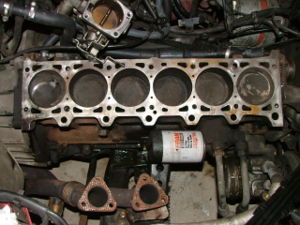
The BMW M30 is a SOHC straight-six petrol engine which was produced from 1968 to 1995. With a production run of 27 years, it is BMW's longest produced engine and was used in many car models.

The BMW M10 is a SOHC four-cylinder petrol engine which was produced from 1962-1988. It was BMW's first four-cylinder engine since the BMW 309 ended production in 1936 and was introduced in the New Class sedans.

The BMW M40 is an SOHC straight-four petrol engine which was produced from 1987–1994. It served as BMW's base model four-cylinder engine and was produced alongside the higher performance BMW M42 DOHC four-cylinder engine from 1989 onwards.

The BMW M50 is a straight-6 DOHC petrol engine which was produced from 1990 to 1996. It was released in the E34 520i and 525i, to replace the M20 engine.

The BMW M52 is a straight-6 DOHC petrol engine which was produced from 1994 to 2000. It was released in the E36 320i, to replace the M50. The BMW S52 engine is a high performance variant of the M52 which powered the American and Canadian market E36 M3 from 1996 to 1999.
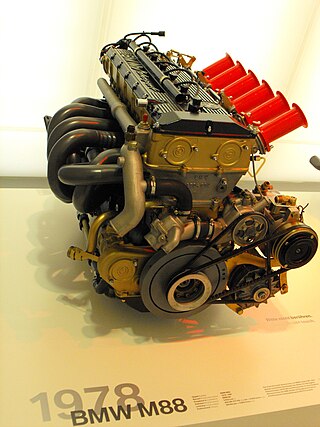
The BMW M88 is a straight-6 DOHC petrol engine which was produced from 1978 to 1989. It is based on the DOHC version of the BMW M49 engine, which was used in the BMW 3.0CSi racing cars.

BMW M62 is a naturally aspirated V8 petrol engine which was produced from 1995 to 2005. A successor to the BMW M60, the M62 features an aluminium engine block and a single row timing chain.

The BMW E12 is the first generation of 5 Series executive cars, which was produced from 1972 to 1981 and replaced the saloon models of the BMW New Class range.

The BMW E23 is the first generation of the BMW 7 Series luxury cars and was produced from 1977 until 1986. It was built in a 4-door sedan body style with 6-cylinder engines, to replace the BMW 'New Six' (E3) sedans. From 1983 until 1986, a turbocharged 6-cylinder engine was available.

The BMW E24 is the first generation of BMW 6 Series range of grand tourer cars, which was produced from January 1976 to 1989 and replaced the BMW E9 coupé.
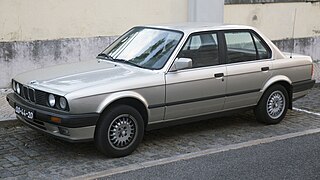
The BMW E30 is the second generation of BMW 3 Series, which was produced from 1982 to 1994 and replaced the E21 3 Series. The model range included 2-door coupe and convertible body styles, as well as being the first 3 Series to be produced in 4-door sedan and wagon/estate body styles. It was powered by four-cylinder petrol, six-cylinder petrol and six-cylinder diesel engines, the latter a first for the 3 Series. The E30 325iX model was the first BMW to have all-wheel drive.

The fourth generation of the BMW 3 Series range of compact executive cars is designated under the model code E46, which was produced by the German automaker BMW from 1997 to 2006, and was the successor to the E36 3 Series which ceased production in 2000. First introduced in November 1997, the E46 was available in sedan, coupé, convertible, station wagon and hatchback body styles. The latter has been marketed as the 3 Series Compact.

The B-series are a family of inline four-cylinder DOHC automotive engines introduced by Honda in 1988. Sold concurrently with the D-series which were primarily SOHC engines designed for more economical applications, the B-series were a performance option featuring dual overhead cams along with the first application of Honda's VTEC system. To identify a Honda B-series engine, the letter B is normally followed by two numbers to designate the displacement of the engine, another letter, and in US-spec engines, another number. The Japanese spec-engines are normally designated with a four character alphanumeric designation. The B-series, the B20B variant in particular, is not to be confused with the earlier Honda B20A engine introduced in 1985 and primarily available in the Prelude and Accord-derived vehicles from 1985 to 1991. While sharing some design elements and both being multivalve Honda four-cylinders, the B-series and B20A differ substantially in architecture, enough to be considered distinct engine families.

The BMW M54 is a naturally aspirated straight-6 petrol engine produced from 2000 to 2006. It was released in the E53 X5 and is the replacement for the M52 engine. The S54 is the equivalent high performance engine, used in the E46 M3, the Z3 M Coupé/Roadster and the E85/E86 Z4 M. The BMW M56 SULEV engine is based on the M54.

Motronic is the trade name given to a range of digital engine control units developed by Robert Bosch GmbH which combined control of fuel injection and ignition in a single unit. By controlling both major systems in a single unit, many aspects of the engine's characteristics can be improved.

Prince is the codename for a family of straight-four 16-valve all-aluminium gasoline engines with variable valve lift and variable valve timing developed by PSA Peugeot Citroën and BMW. It is a compact engine family of 1.4–1.6 L in displacement and includes most modern features such as gasoline direct injection and turbocharger.

The BMW N46 is a naturally aspirated inline-four piston engines which replaced the BMW N42 and was produced from 2004 to 2015.
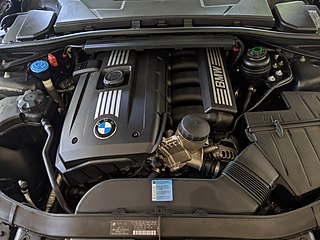
The BMW N52 is a naturally aspirated straight-six petrol engine which was produced from 2004 to 2015. The N52 replaced the BMW M54 and debuted on the E90 3 Series and E63 6 Series.

The EA827 family of petrol engines was initially developed by Audi under Ludwig Kraus leadership and introduced in 1972 by the B1-series Audi 80, and went on to power many Volkswagen Group models. This is a very robust water-cooled engine configuration for four- up to eight- cylinders. In Brazil this engine was produced under the name Volkswagen AP AP.
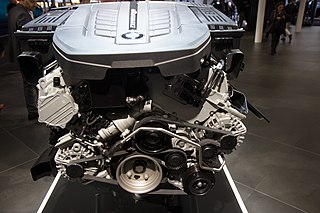
The BMW N74 is a twin-turbo V12 petrol engine which replaced the N73 and has been produced since 2008. It is BMW's first turbocharged V12 engine and is also used in several Rolls-Royce models.



